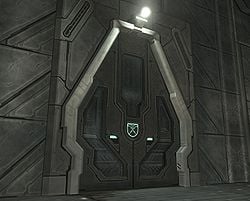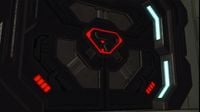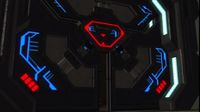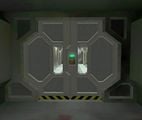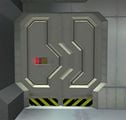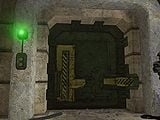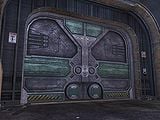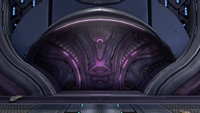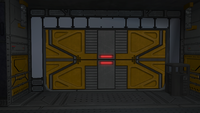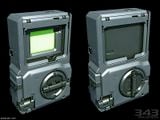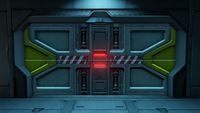Door
From Halopedia, the Halo wiki
Doors are movable barriers used to cover up openings; typically, such barriers are attached to the very openings they block. Doors are a basic component of architecture among all known major civilizations.
Background
Like all technology created by the various factions of the Halo universe, the doors they create for various purposes represent their general design styles in many ways.
Covenant
The Covenant frequently use curves as well as bright purples, blues, and grays in the design of their technology; everything from weapons to cities. The doors incorporate the curves and colors standard to Covenant design, most notably in High Charity. While many doors throughout the Halo Universe have indicator lights and work by sliding in and out of the walls, only the doors in High Charity flash when the player gets close and emit a tone.[1][2][3]
Humanity
Human technology for doors has progressed since the modern era. While most doors today are based on a hinge system, the doors seen on Earth are almost exclusively sliding (except for the antiquated doors in Crow's Nest),[4] either opened by proximity or a switch located on the door itself. Like most human technology applied to everything from roads to spacefaring military vessels, the design is simple and geometric (with some discrepancies) with straight lines and angles, and involves blacks, grays, and browns. Most doors have a light on them that is either green to indicate that it is open or can be opened, or red to indicate that it is locked.[5][6][7] While human doors usually consist of one or two sliding segments, there are some exceptions, such as the multi-segmented doors in some of Reach's industrial facilities.[8][9] Reinforced blast doors are a common sight in military bases and starships,[4][5] but are also used in cities to close off certain sections in emergencies.[10]
Forerunner
Doors built by the Forerunners are completely geometric and incorporate the similar light grays, browns, and blues of the rest of their technology. The doors themselves are geometric and often slide in multiple parts. They also have complex and geometric designs on them, it is often patterned. This same trend can be seen on floors of Forerunner structures.[11][12][13]
Flood
- Main article: Porta
While the Flood do not have what we consider conventional architecture, they build their structures out of biomass they have consumed. Their doors, called Portas, are built from biomass of infected hosts, and resemble valves like those in the heart. They open based on proximity. While the sections of the door itself retract, the circular frame of the door contracts at the same time. This effect was most likely added by Bungie to make the player feel as if they were playing inside a living thing during the level, and add effect to the level.[3][14]
Trivia
The object John-117 rode to Earth in the beginning of Halo 3, is apparently some sort of Forerunner door, part of the Forerunner Dreadnought.
Gallery
A Forerunner door on Installation 04 in Halo: Combat Evolved.
A closed Forerunner door on the Threshold Gase Mine in Halo 2.
One set of bulkhead door on the UNSC Pillar of Autumn.
A door in Crow's Nest.
A door in Traxus Factory Complex 09.
A door in High Charity
Another Covenant door onboard a CAS-class Assault Carrier in Halo Legends: The Package.
A set of blast doors on Cairo Station.
A door in a BXR Mining facility on Reach.
A set of blast doors on Cairo Station in Halo 2: Anniversary.

|
Browse more images in this article's gallery page. |
Sources
- ^ Halo: Combat Evolved, campaign level, The Truth and Reconciliation
- ^ Halo 2, campaign level, Gravemind
- ^ a b Halo 3, campaign level, Cortana
- ^ a b Halo 3, campaign level, Crow's Nest
- ^ a b Halo: Combat Evolved, campaign level, The Pillar of Autumn
- ^ Halo 2, campaign level, Cairo Station
- ^ Halo 3, campaign level, The Storm
- ^ Halo: Reach, campaign level Tip of the Spear
- ^ Halo: Reach, campaign level The Pillar of Autumn
- ^ Halo 3: ODST, campaign level Mombasa Streets
- ^ Halo: Combat Evolved, campaign level, The Silent Cartographer
- ^ Halo: Combat Evolved, campaign level, Assault on the Control Room
- ^ Halo 2, campaign level, The Arbiter
- ^ Halo 3, campaign level, Isolation
